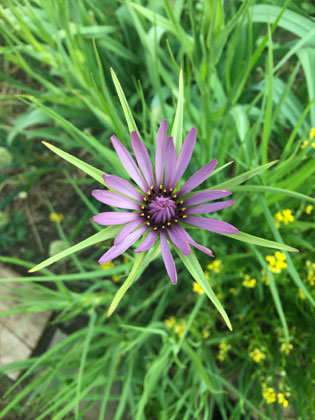
- Edimentals
Salsify
Tragopogon porrifolius
This relative of the dandelion has a beautiful flower, edible taproot and spring shoots.
PLANT TYPE Vegetable
PLANT HABIT Self-sowing
USES Culinary, Pollinators, Ornamental
DESCRIPTION
This relative of the dandelion has an edible taproot that looks much like a parsnip and edible spring shoots. Was once a popular vegetable, beloved by folks in Victorian times. Now it’s rare to find this plant for sale.
Salsify is has beautiful purple-pink flowers that open and close every day and night, making it an interesting and ornamental addition to any food garden.
Salsify is rich in fiber as well as nutrients like iron, vitamin C, thiamin, calcium, potassium, and phosphorous. It has a mild flavour is often compared to oysters. In spring the young edible shoots (which can be blanched by mounding soil), taste of asparagus. The leaves are best when collected before the flower stalk is produced. The roots can be used in much the same way as any other root vegetable – mashed, boiled, roasted or purée.
Also known as purple or common salsify, oyster plant, oyster root, Jerusalem star, Jack go to bed, goatsbeard.
RECOMMENDED LOCATION Kitchen garden, Ornamental garden
Aspect Full sun
Height 0.6-1.2m
Spread 0.3m
Hardiness Hardy in UK WInter
Management and care While it’s close and cultivated relative Scorzonera is perennial, Salsify is biennial. However, it self seeds spectacularly well and if you leave it in any perennial vegetable patch it will be back in abundance.
Origin/history
Tragopogon porrifolius is a common biennial wildflower, native to southeast Europe and north Africa, but introduced elsewhere, for example, into the British Isles (mainly in central and southern England), other parts of northern Europe, North America and southern Africa, and in Australia.
The plant originated in the eastern Mediterranean region and was introduced by the Romans to the rest of Europe and the British Isles. Its wild form, Tragopogon porrifolius subsp. eriospermus, is still found today in large areas of Greece, Italy and Turkey.
Salsify was generally treated as a wild-harvest plant until the 17th century, when gardeners brought it under cultivation in order to improve the size of the roots. However, with the advent of refrigeration, people started using vegetables that were more difficult to preserve, and the once-popular salsify faded into obscurity.
Some of the earliest experimentation with cultivating Salsify took place in Switzerland, which is generally considered the homeland of the best salsify strains.
The two species of salsify in the UK have different coloured flowers, purple in the case of common salsify and yellow in the case of goat’s-beard.
Its Latin species name, porrifolius, means “leek leaved”.
